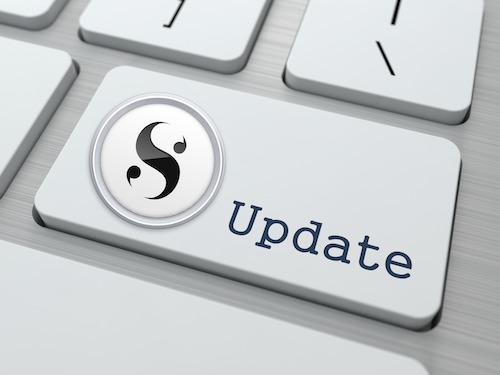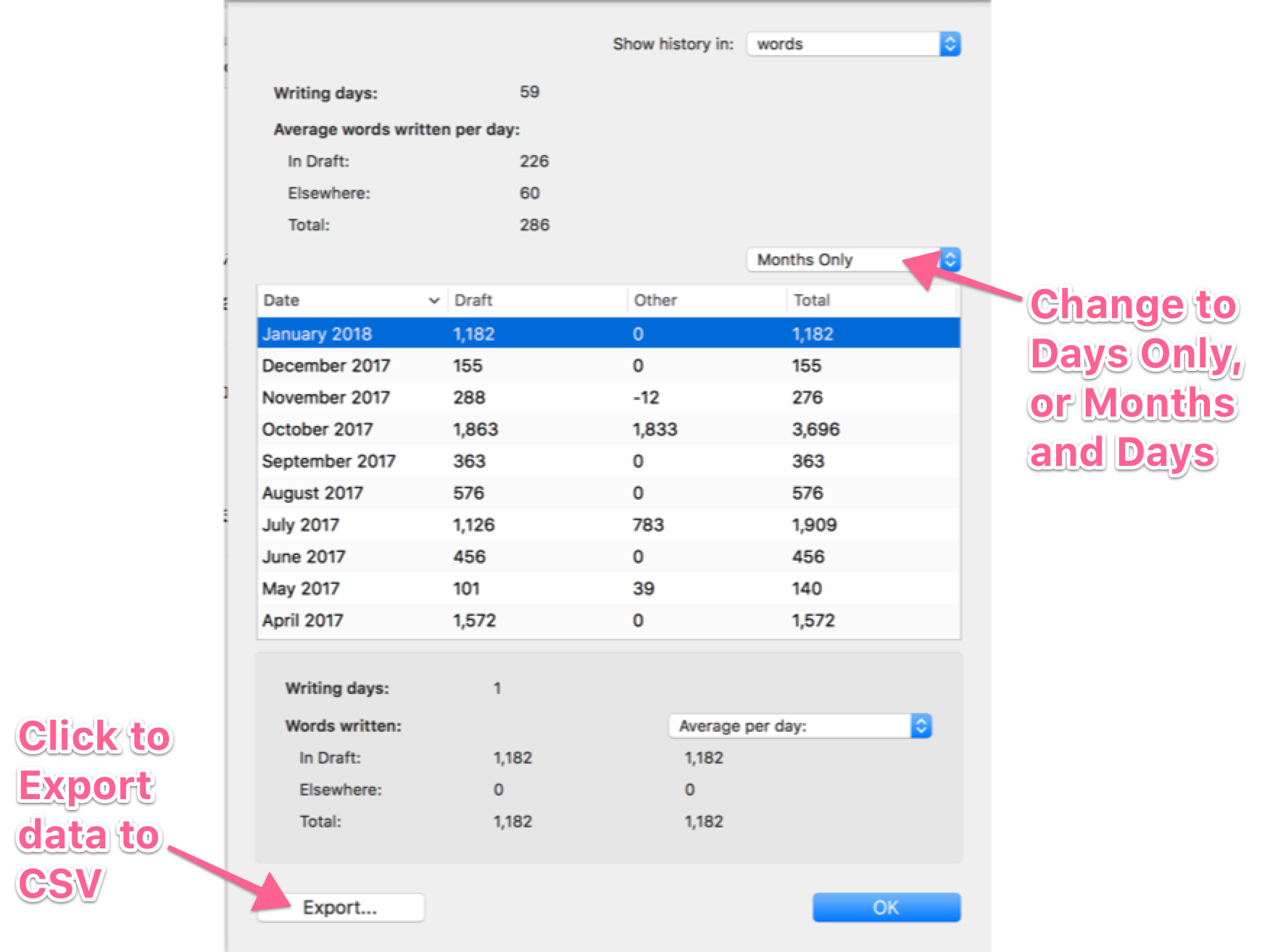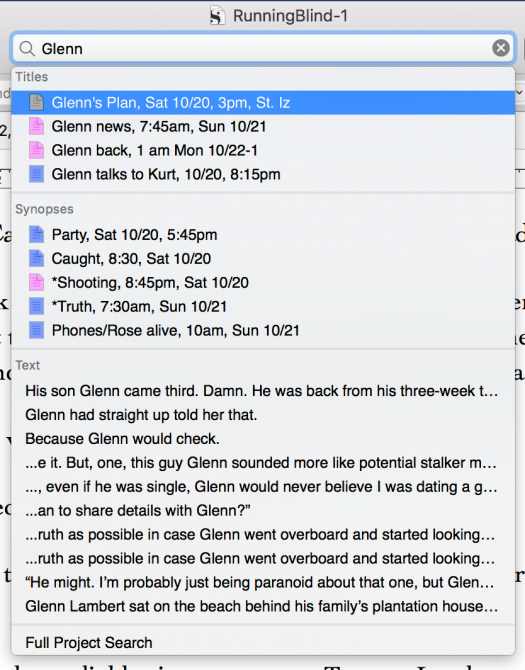New Year, New Scrivener
By Gwen Hernandez | January 12, 2018 |
 Did you hear? Scrivener 3 for Mac released in November (Windows is in beta now and due out later this year), and the upgrade brings some cool new features.
Did you hear? Scrivener 3 for Mac released in November (Windows is in beta now and due out later this year), and the upgrade brings some cool new features.
Below are some of the tools (available for both Mac and PC) that I found most exciting while parsing through the changes for a free mini-course I created to help Scrivener 2 users transition to the new version.
Writing History
You’ve always been able to track your word count and progress in Scrivener, but if you wanted to keep a log of your daily word count, you had to manually enter it into a spreadsheet. By popular request, Scrivener 3 solves that with Writing History.
You can now view your word counts for each project by day, month, or day with monthly subtotals. Better yet, you can export the data to a CSV file for viewing in any spreadsheet program.
To access Writing History, go to Project>Writing History.
Styles
Scrivener users have been begging Literature & Latte for true, word-processor-like styles for as long as I can remember. Wish granted. With the old presets, Scrivener didn’t “remember” how a section of text came to be formatted—whether manually or via preset. You could apply a preset for quick formatting, but changing the appearance of, say, all email exchanges between your characters meant combing through the manuscript for every instance.
With styles, if you change the format of (i.e. redefine) a style, it updates all text formatted using that style throughout your manuscript.
You can also change how text formatted with a certain style appears when you compile.
I needed this recently for a manuscript that contained text messages between characters. I wanted the text formatted one way for ebooks and another for print. With the new styles function, problem solved. Slick, right?
Searchable Snapshots
Snapshots have always been a great way to keep versions of your scenes, but they had one flaw. You couldn’t search all snapshots at once. Let’s say you knew one of your early scenes mentioned a specific event that you’ve since written out of your manuscript. Now, you want to grab a conversation from that old scene, but after copious revisions you can’t remember which current scene it spawned.
Previously, you would’ve had to view the Snapshots for each possible scene and then you could run a search on the list using Command+F (Mac) or Ctrl+F (Windows).
No longer! To search all snapshots in a project for any word or phrase, go to Documents>Snapshots>Show Snapshots Manager. Type the desired text in the Search box and you’ll get a list of snapshots meeting the search criteria. Click any snapshot to view its contents.
Quick Search Bar
I didn’t even know I wanted this until I saw it. You’ve always been able to use Project Search to get a list of documents containing specific text, but with the Quick Search bar—located in the center of the toolbar, displaying the document name—you can see the search term in context, making it easier to locate the instance you want.
If applicable, you’ll see results from document titles, synopses, and text. Click the desired result to jump to directly to that document in your manuscript.
Project-specific Backup Locations
I’ve been waiting years for this one. When you choose your backup settings under Scrivener>Preferences>Backup (Mac) or File>Options>Backup (Windows), you can only choose one location that applies to all projects on that computer.
But now, you can override the global backup location for any project by going to Project>Project Settings>Backup and selecting the option to “Use custom backup folder for this project.” Click Choose and select your location.
What About Compile?
The compile feature got a big overhaul in an attempt to make it simpler for those who don’t want to dig in to the details. Is it easier or less confusing? The jury’s still out. If you were proficient with Compile in the old version, you’ll be happy to know that most of the options tabs are still there, just hidden.
If you weren’t comfortable with the old Compile, I’d love to know what you think of the new version.
These are just a few of my favorite new things in Scrivener 3. Have you noticed anything cool that I didn’t mention? Did you have a wish list item that you’re not sure made it into the update? Any other questions about Scrivener? Ask away.









Windows users:
I’ve been using the open Beta, and have found it stable, with at least as much functionality as the old 1.9 Windows version.
You can check the L&L forums for bug reports on it. For me, none of them are show-stoppers. Only one annoys me: the current inability to and words to the spell-check dictionary. There’s another rev of the Beta coming out by the end of the month, I won’t be surprised if this bug is fixed in it. :)
Scrivener has always been a great program at a great price. The new functionality in the 3.0 Beta (like being able to open any part of a project in a separate window as a Quick Reference) is a welcome addition.
PCGE: Yes, the Windows upgrade is going to bring so many great features to the software, both some that Mac has had for a while, and many that are also new to Mac. Pretty close to feature parity between the two, which will be great.
Styles alone would be worth the upgrade. Even in the middle of a book. Especially in the middle of a book.
I have a lot of complicated formatting – it would be nice not to have to work so hard at maintaining it!
The features I would really like are probably not there – right indent passed to the epub or print, and widows and orphans control – but Scrivener is not a word processor (as it mentions several times), only an almost perfect imitation of one for many things.
I look forward to seeing the new Compile version. And thanks for the mini-lesson – if it’s anything like your courses, it’s a keeper.
Hi, Alicia! I agree, styles are pretty useful.
Right-indent should pass to most formats (not 100% sure about ebooks off the top of my head), but you have to ensure that the right-indent value you’re using comes within your margins. IOW, if in your editor it’s set at 9″, Scrivener will adjust all the word wrapping to match the output, and the right indent will fall inside your page dimensions, but no further. So, if you’re outputting to PDF with 8.5×11 paper, make sure you’ve set the right indent for the special section to something less that 8.5 minus your margins, say 6″.
Styles appear to persist without you needing to use Preserve Formatting, which is great, but that would be another thing to check if you brought in the right indent for a paragraph and weren’t using a style. You’d need to preserve the formatting (Format>Preserve Formatting) to make it stick during compile.
Widow and orphan control is available for word processor output types like DOCX and RTF in Compile under the Text Layout tab (formerly Layout). Unfortunately, not for PDF. Thanks!
Don’t think I’ll find the right indent feature, but I’ll look. I don’t mind a cleanup pass through Word for a few things.
BUT I tried to upgrade, to find you have to have OX 10.12 or higher, and I have a nice stable Yosemite which is 10.10 something. Must use some new features.
I would have changed my Scrivener program halfway through my trilogy, but I refuse to touch my operating system when my eldest warns me of problems. I can’t deal with problems.
Too bad. Will when I have 10.12 something.
Thanks, Gwen! I look forward to your Scrivener posts because I always learn something new. I’ve been waiting impatiently for the Windows Scrivener upgrade since it was announced. My main hope was for the compile feature to be a bit more intuitive. Good to see that has been addressed. The word count history is an unexpected bonus. Can’t wait!
Thanks also to poster PCGE for the open beta update.
I appreciate that, CherylPR! Here’s to a short wait for S3 for Windows. :-)
I use it on my Mac and so far I like it a lot! The writing history is cool to give yourself that “well done today” feeling. I had not found the “quick search” yet, so thanks for that info – really goodl!
As for the compile, I have not used it a lot so far, only for exporting a quick pdf for my trusted beta reader, but it looks ok.
And I really like the new “arrange by label” feature: I am labelling my scenes by POV character now and like to look how the different point of views weave through my draft.
I’m glad you’re enjoying Scrivener 3, J! I haven’t had a chance to use the colored threads in the Corkboard for my own work yet, but I’m starting a new book, so I’ll be curious to see how it works for me. I label scenes by POV too, at least during the drafting phase.
Happy writing!
Not sure I’m going to like getting rid of project notes. Just replacing Refs and the other thing would have been enough for Bookmarks.
Hi, Claudia. I do miss the old style of project notes, but I’m trying to adjust or find new ways to keep that information handy instead. I hope the good changes outweigh any negatives for you!